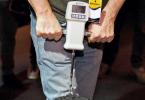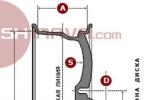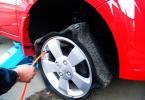An ignition distributor sensor (1908.3706) is installed on the ZMZ0-402 engine - contactless, with a sensor (generator) of control pulses and built-in vacuum and centrifugal ignition timing controllers.
The distributor sensor performs two functions: it sets the moment of sparking and distributes high voltage pulses through the cylinders in accordance with the order of their operation. For this, a slider is put on the shaft of the distributor sensor.
An interference suppression resistor * is installed in the slider.
The switch (1313734) opens the power supply circuit of the primary winding of the ignition coil, converting the sensor control pulses into current pulses in the ignition coil.
Ignition adjustment ZMZ 402
1 Set the crankshaft to a position corresponding to an ignition timing of 5 °.
2. To do this, on the ZMZ-402 engine, we combine the middle mark on its pulley with the tide on the block cover (the end of the compression stroke of the first cylinder).
3. For the UMZ-4215 engine, set the first mark on the pulley against the pin on the timing gear cover.
4. If the distributor sensor is not removed from the engine, then the compression stroke of the first cylinder is determined by removing the distributor cover, the slider must stand against the internal contact of the cover, connected by a wire to the spark plug of the first cylinder.
Otherwise, turn out the spark plug of the first cylinder. After closing the hole with a paper stopper, we rotate the crankshaft. The air pushed out of the plug will indicate the start of the compression stroke.
4. Using the "10" key, loosen the octane-corrector screw
5 . We set its scale to zero division (the middle of the scale).
6. Using the "10" key, loosen the screw that secures the octane-corrector plate
Adjusting the ignition timing of the ZMZ-4027 engine. Turning the housing of the distributor sensor, we combine the "marks" (red line on the rotor and the arrow on the stator). While holding the sensor in this position, tighten the screw.
Make sure that the slider is located against the contact of the cover of the first cylinder and check the correct connection of the high-voltage wires of the remaining cylinders - counting counterclockwise from the first cylinder in the order 1-2-4-3.
After you have done everything, check that the ignition timing is set correctly while the car is moving. We start the engine, warm it up and when we have already switched to fourth gear at a speed of 50-60 km / h, we sharply press on the gas. If at the same time detonation (it sounds like a knock of valves) appears for a short time - for 1-3 seconds - the ignition moment is selected correctly. Prolonged detonation indicates an excessive ignition timing, we reduce it with an octane corrector by one division. The absence of detonation requires an increase in the ignition timing, after which the check must be repeated.
Location of MAIN units. IN THE ENGINE COMPARTMENT: 1 - coolant supply pipe to the radiator; 2 - air filter; 3 - cylinder head cover; 4 - sensor-distributor; 5 - ignition coil; 6 - vacuum brake booster; 7 - plug of the oil filler neck; 8 - fine fuel filter; 9 - thermostat 10 - radiator casing 11 - radiator
Description of construction
The ZMZ-402 engine is carburetor, four-cylinder. The cylinder block is made of aluminum alloy. Cast iron cylinder liners, removable. The main bearing caps and clutch housing are machined together with the block and are therefore not interchangeable.
The engine crankshaft is cast-iron, five-bearing, dynamically balanced with a flywheel and a clutch drive plate. Axial movement of the shaft is limited by two thrust washers located on both sides of the front main bearing.
A camshaft with five bearing journals of different diameters is installed in the cylinder block. On the shaft the gear wheel of the drive of the ignition sensor-distributor and the oil pump is cut.
The camshaft is driven through a textolite or polyamide gear that meshes with the crankshaft gear. The camshaft cams act on the tappets. The pusher rods operate the valves through the rocker arms.
The engine lubrication system is combined. An oil cooler is installed to cool the oil. At a pressure in the system of 0.7-0.9 kgf / cm2, the safety valve opens and the oil enters the radiator, and then drains into the engine crankcase. A tap is provided to turn off the oil cooler. When the handle is positioned along the hose, it is open.
The cooling system is liquid, closed. An additional electric fan is installed in front of the radiator.
The intake pipe is heated by the exhaust gases. The heating regulator has two positions - "winter" and "summer".
Slider resistance, kOhm 5-8
Tip resistance
candles, kOhm 4-7
Resistance of the central contact of the cover *, kOhm 8-13
Winding resistance
stator, kOhm 0.4-0.45
* On some of the sensors, instead of a resistance, a carbon contact is installed.
ENGINE IGNITION SYSTEM ZMZ-402
The ignition system is non-contact. It consists of a switch distributor sensor, an ignition coil, spark plugs and high and low voltage wires. Ignition distributor sensor (1908.3706) -contactless, with a sensor (generator) of control pulses and built-in vacuum and centrifugal ignition timing controllers.
The distributor sensor performs two functions: it sets the sparking moment, distributes high-voltage pulses over the cylinders in accordance with the order of their operation. For this, a slider is put on the shaft of the distributor sensor. A noise suppression resistor with a resistance of 8000-13000 Ohm is installed in the slider.
The switch (1313734) opens the power supply circuit of the primary winding of the ignition coil, converting the sensor control pulses into current pulses in the ignition coil.
Technical characteristics of the ignition system
The order of operation of cylinders 1-2-4-3
Direction of rotation against
distributor rotor clock
Ignition timing
centrifugal regulator 15-18
vacuum regulator 8-10
Spark plugs А14ВР
Spark plug gap, mm 0.8-0.95

Ignition distributor sensor:
1 - case; 2 - weight of the centrifugal engine; 3 - bearing fastening screw; 4 - vacuum regulator; 5 - spring of the vacuum regulator; 6 - diaphragm; 7 - fitting; 8 - rotor magnetic circuit; 9 - permanent magnet of the rotor; 10 - rotor; II - cover; 12 - noise suppression resistor; 13 - central conclusion; 14 - central contact; 15 - slider; 16 - felt; 17 - rotor fastening screw; 18 - stator winding; 19 - stator fastening screw; 20 - stator; 21 - magnetic core of the stator winding; 22 - stator support; 23 - bearing; 24 - weight spring; 25 - thrust washers; 26 - bushing; 27 - roller; 28 - octane corrector; 29 - thrust washer; 30 - retaining ring; 31 - pin; 32 - drive clutch.

Generator 1631.3701:
1 - rotor; 2 - bushing; 3 - front bearing; 4 - bushing; 5 - washer with nut; 6 - key; 7 - pulley; 8 - fan; 9 - front cover; 10 - stator; 11 - rotor winding; 12 - brush holder; 13 - brush springs; 14 - brushes; 15 - rear bearing; 16 - cover; 17-shaft; 18 - slip rings; 19- output of the stator winding; 20- plate-holders; 21 - back cover; 22 - stator set; 23 - stator winding.
Generator 1631.3701 of the ZMZ-402 engine
Generator 1631.3701 is a three-phase synchronous electric machine with electromagnetic excitation and a built-in rectifier on silicon diodes. The alternator rotor is driven by a V-belt from the engine crankshaft pulley.
The stator and generator covers are tightened with four screws. The rotor shaft rotates in ball bearings installed in the covers. The bearings are lubricated for the entire life of the generator. The rear bearing is pressed onto the rotor shaft and is pressed by the rear cover through a plastic bushing. The front bearing is mounted on the inside of the front cover and is tightened with a washer with four screws.
In the stator of the generator there are two three-phase windings made according to the "star" scheme and connected in parallel to each other. Rectifier - bridge circuit, consists of six diodes. They are pressed into two horseshoe-shaped aluminum plate-holders. The plates are integrated into a rectifier unit, fixed inside the generator back cover.
The excitation windings of the generator are located on the rotor. The winding leads are soldered to two copper slip rings on the rotor shaft. Power is supplied to them through two carbon brushes installed in the brush holder.
The generator works in conjunction with a voltage regulator, which is attached to the mudguard of the right side member under the expansion tank. If the regulator fails, it is replaced.
To protect the electronic equipment of the car from voltage pulses in the ignition system, as well as to reduce radio interference, a capacitor is connected between the "+" and "ground" of the generator.
The internal windings of the generator and the rectifier unit are cooled by air through the windows in the covers from a centrifugal fan mounted on the rotor shaft.
Technical characteristics of the generator 1631.3701
Rated voltage, V 14
Maximum current, A 65
Adjustable voltage, V 13-15
Resistance
excitation winding, Ohm 2.5
The starter is a four-pole four-brush DC motor with permanent magnet excitation, roller freewheel and two-winding traction relay.
The torque from the armature shaft is transmitted to the drive pinion through a roller overrunning clutch.
Starters for ZMZ-4062 and ZMZ-402 engines are not fundamentally different. Starter 42.3708-10 is installed on the ZMZ-4062 engine on the right side, ST203-B4 - on the ZMZ-402 engine on the left.
Technical characteristics of the starter 42.3708-10 (ST230-B4)
Rated power, kW 1.7 (1.0)
Rated voltage, V 12
Power consumption
in a hindered state,
no more, A 700 (550)
Torque,
not less kgf-m 1.6 (2.0)
Current consumption in mode
idling, no more, A 80 (85)

Starter: 1 - protective cap; 2 - locking washer; 3 - brush; 4.5 - conclusions; 6 - traction relay cover; 7 - contact plate; 8 - traction relay; 9 - relay coil; 10 - stock; 11 - returnable spring; 12 - core; 13 - lever; 14 - cover; 15- lever axis; 16- cover extension; 17- video; 18 - driving (driving) gear wheel; 19 - bushing; 20 - spring ring; 21 - persistent bushing; 22 - shaft; 23 - freewheel clutch; 24 - spring; 25 - half-coupling of inclusion; 26 - intermediate support; 27-stator; 28 - stator winding; 29 - rotor (anchor); 30 - collector; 31 - cover; 32 - brush holder.
Four field windings are installed in the steel casing of the starter. The starter housing and covers are pulled together by two studs. The armature shaft rotates in two bronze-graphite bushings installed in the covers and in the intermediate support.
A freewheel clutch (freewheel clutch) with a drive gear is installed on the drive shaft. It transmits torque in only one direction - from the starter to the engine, decoupling them after starting the engine. This is to protect the starter armature from overspeed damage.
The traction relay is used to enter the drive gear into engagement with the gear rim of the flywheel of the engine crankshaft and turn on the power to the starter motor. When the ignition key is turned to the "starter" position, voltage is applied to both windings of the traction relay (retraction and holding). After the contacts of the traction relay are closed, the retraction winding is turned off.
The relay actuation voltage should be no more than 8 V at 20 ± 5 ° С. If not, there is a fault in the relay or actuator. Serviceability of the drive is determined by inspection of the parts after disassembling the starter. The defective relay is replaced.
Distributor sensor 19.3706 of the contactless electronic ignition system of the ZMZ-4021 engine installed on UAZ vehicles is a generator that generates voltage pulses to control a transistor switch, and also serves to distribute high voltage current pulses to spark plugs.
Distributor sensor 19.3706 of the ignition system of the ZMZ-4021 engine.
The distributor sensor has two automatic devices for regulating the ignition timing depending on the engine speed and load. On UAZ vehicles, the 19.3706 distributor sensor works in conjunction with the 131.3734 transistor switch and the B116 or B116-01 ignition.
Installation of the 19.3706 distributor sensor on the ZMZ-4021 engine.
Before installing the distributor sensor on the engine, it is necessary to remove its cover and clean it from dust and dirt. Wipe the inner surface of the cover with a cloth soaked in gasoline. Check for binding of the center contact of the cover. It should be free to sink into the seat of the cover and return under the action of a spring.
After inspecting the cover, reinstall it and securely install the high voltage wires to the slots of the cover until they stop. If the wires are not securely held in the sockets, it is necessary to separate the lugs of the lugs a little.
It should be taken into account that the occurrence of an additional spark gap in the high voltage circuit due to a loose fit of high voltage wires into the sockets of the cover leads to burnout of the cover plastic with subsequent failure of the distributor cover or to disruption of the normal operation of the ZMZ-4021 engine.
It is impossible to file the inner electrodes of the cover or the current-carrying plate of the runner, as this will lead to an increase in the gaps in the high-voltage circuit and may subsequently break down the plastic of the cover or runner. Before installation, it is necessary to lubricate the felt of the rotor axis of the distributor sensor with engine oil; for lubrication, it is necessary to remove the slider.
The serviceability of the distributor sensor must be carried out at a specialized stand. The characteristics of the centrifugal and vacuum automatic devices of the distributor sensor must correspond to the data given in the table below.
If the characteristics of the automatic devices do not correspond to the specified data, the distributor sensor 19.3706 must be replaced or repaired. After installing the distributor sensor on the ZMZ-4021 engine, it is necessary to install the ignition.
Installation of ignition on the ZMZ-4021 engine.
To install the ignition you need:
- remove the cover of the distributor sensor,
- unscrew the first cylinder,
- by closing the hole of the first cylinder plug with your finger, or by rolling a cone cup out of paper and inserting it into the hole for the spark plug, turn the engine crankshaft with the starting handle until the air starts to escape, this will happen at the beginning of the compression stroke,
- after making sure that compression has started, carefully turn the engine shaft until the pointer coincides with the second one on the crankshaft pulley,
- make sure that the slider is against the inner contact of the cover, connected to the wire going to the spark plug of the first cylinder,
- set the octane-corrector scale to zero division,
- loosen the bolt fastening the distributor sensor to the octane-corrector plate, it is located on the lower part of the distributor housing, and turn the distributor sensor housing until the red mark on the rotor and the arrow on the stator of the distributor sensor match,
- keeping the distributor housing from turning, tighten the fastening bolt and put the cover back in place,
- check the correctness of the connection of the wires from the spark plugs, starting from the first cylinder, the wires must be connected in the order 1, 2, 4, 3, counting counterclockwise.
After each ignition setting, as well as changing the type of fuel, it is necessary to clarify the setting of the ignition moment by listening to the engine when the car is moving. The adjustment of the ignition installation must be done with an octane corrector, without loosening the bolt fastening the housing of the distributor sensor. When turning the distributor sensor housing clockwise, the ignition setting will be earlier, counterclockwise - later.
Installation of the ignition system
For measured, economical operation of the motor, correct installation of the ignition system... For complete combustion of fuel, the spark discharge in the spark plug must be earlier top dead points of the cylinder piston, as it takes time for the fuel to burn. The angle of rotation of the crankshaft from the moment of spark discharge to top dead center called the ignition timing.
Installation of the ignition system.
To start the engine, simply install ignition at the moment the piston passes the top dead center or close to this moment. Installation of the ignition system required when removing the distributor on VAZ cars and removing the distributor drive on GAZ, ZIL, AZLK, etc.
Methods for installing ignition.
At installation ignition system there are two ways.
The first way to install the ignition.
The first method is suitable for all engines with a contact or contactless ignition system. For installation, the plug of the first cylinder is unscrewed, and the hole is plugged with a finger (when installed with an assistant) or a loose plug made of paper or other material. After that, the engine is cranked with the crank, and in its absence, with the raised drive wheel when the gear is engaged. Increasing the pressure in the cylinder under the finger or knocking out the plug means the piston moves upward during the compression stroke.
After determining the compression stroke, the top dead center marks must be aligned. The location of the labels is individual for each engine. For VAZ, GAZ-402 engines, they are located on the crankshaft pulley and front cover; for GAZ-52, GAZ-66 engines, they are located on the flywheel and flywheel casing.
Setting the ignition timing on ZMZ 402 GAZ, UAZ (contactless)
Setting the moment ignition on engine ZMZ 402 Volga, UAZ. (Contactless)
Installing a distributor with a drive
correct installation of a distributor with a drive on a UAZ vehicle.
After installing the top dead center, the distributor must be installed in such a way that the slider is directed to the output of the first cylinder of the distributor cover. When installing the GAZ, UZMI ignition system with a contactless distributor, it is necessary to combine the mark on the anchor of the distributor with the arrow on the stator.
If all actions are performed correctly and there is no malfunction of other systems, engine should start.
The second way to install the ignition.
For four-cylinder engines, it is possible not to determine the compression stroke for the first cylinder, but it should be borne in mind that when setting the top dead center marks, the compression stroke can be in the first or fourth cylinder.
When installing the distributor in this case, the labels are first set top dead center, as described in the first case and, as in the first case, the distributor is installed in place.
If it does not start when you try to start the engine, then you need to unfold the wires on the distributor cover. To do this, you need to swap the wires of the first cylinder with the fourth cylinder and, accordingly, swap the wires of the second and third cylinders.
Ignition adjustment.
After starting the engine, it is necessary to adjust the ignition timing. There are two ways to adjust, with a stroboscope and by ear while driving.
When adjusting the ignition with a stroboscope, the moment the spark discharge occurs and the alignment of the cylinder top dead center marks is controlled. Strobe timing is accurate but rated for reference engine and quality gasoline. Therefore, as practice has shown, it is better to set the ignition moment by ear when the car is moving.
For installation by ear on a straight, level road at a speed of 40 km / h. a sharp press on the gas pedal is made. When pressed hard, a brief metallic knock should be heard in the engine. Usually, in this case, they say the knock of the piston fingers, but in fact it is the knock of the piston skirt against the cylinder walls when the piston moves upward when fuel combustion has occurred and the pressure on the bottom of the piston is excessive.
If there is no knock, the ignition is later, with a prolonged knock, early. This adjustment is recommended after each refueling, due to the discrepancy between the actual octane number and the declared one.



